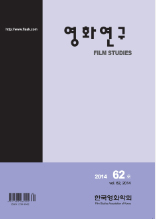- 영문명
- An Analysis of the Shots of Living Space and Landscape Paintings in 'Amour'
- 발행기관
- 한국영화학회
- 저자명
- 주진숙
- 간행물 정보
- 『영화연구』제62호, 337~360쪽, 전체 24쪽
- 주제분류
- 예술체육 > 예술일반
- 파일형태
- 발행일자
- 2014.12.31

국문 초록
영문 초록
In Michael Haneke's 2012 film Amour, two sets of shots are presentedambiguously at the crucial moments of main character's elderly lives. Oneis a series of landscape shots taken from the oil paintings, which havebeen hung on the walls of their living space, and the other are five stillshots of their living room, kitchen, dining room, bedroom and lobby area. Those shots were presented with a shock so that they attracts viewers'attention and make them reflect on the theme of the film, that is deathresided in their space and repressed as a sign of forthcoming disaster themain characters have to confront. This paper tries to investigate on themeaning of the shots in relation with the theme of Michael Haneke'souvre, especially those deal with suicidal acts. The shots of landscapepaintings reveal a sense of uncanny, emanated from an invisible realitythat has been existed in their living space but they have not owned, thatis death. The shots of their living space correspond with the shots oflandscape paintings, producing the paradoxical meaning of living space asa reflection on the consciousness of human being thrown into the world. And this leads us to read this space as heterotopia, spaces that have morelayers of meaning or relationships to other places than immediately meetthe eye. Furthermore, Haneke plays with the icons of horror-disaster genremovie with the space in favor of self-determination for death of the maincharacters. For Haneke, suicide might be an authentic and ethical act that rejects or intervenes the symbolic system, thus results in radical self-destruction.
목차
1. 들어가며
2. 그들이 소유한 풍경/자연/죽음
3. 거주공간의 외부로부터의 침입
4. 유토피아에서 헤테로피아로: <아무르>의 거주공간
5. 죽음의 자기결정권
6. 결론
해당간행물 수록 논문
참고문헌
최근 이용한 논문
교보eBook 첫 방문을 환영 합니다!

신규가입 혜택 지급이 완료 되었습니다.
바로 사용 가능한 교보e캐시 1,000원 (유효기간 7일)
지금 바로 교보eBook의 다양한 콘텐츠를 이용해 보세요!


